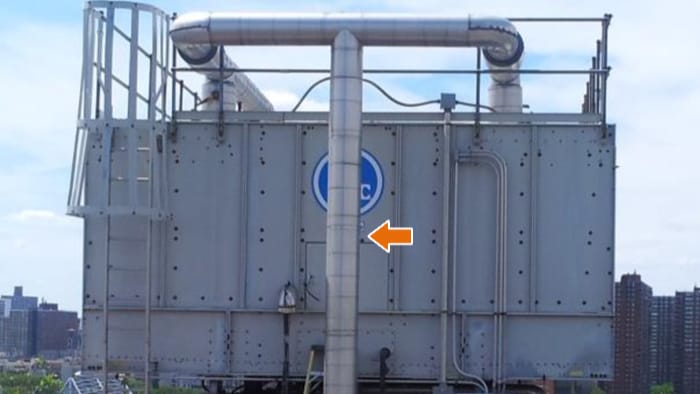

Cooling towers can cause outbreaks of Legionnaires' disease when not adequately maintained. In an outbreak scenario, identifying cooling towers quickly and accurately is essential to limiting the number of people exposed. However, searching for cooling towers during an outbreak can be difficult due to
Use our steps and strategies -- alone or in combination -- to locate cooling towers. Additional research and development of new cooling tower identification technologies may improve speed and accuracy by reducing opportunities for human error.
All cooling towers have three telltale characteristics:
Cooling towers A are often confused with refrigerant-based air conditioner (AC) units. These general characteristics and features of cooling towers help distinguish them from AC units:
Cooling towers are heat rejection devices that transfer heat to the atmosphere through evaporation. Most common uses include air conditioning and removing heat from commercial and industrial processes. Cooling towers are inherently more efficient than air conditioners. As such, certain types of buildings are more likely to have cooling towers.
Look for larger buildings with significant air conditioning requirements, such as
Look for buildings housing commercial or industrial processes, such as
Keep in mind that cooling towers may be in operation during the winter because industrial processes sometimes use them.
Home and car AC units do not use water to cool the air. For this reason, they are not a risk for Legionella growth or spread.
When investigating a community outbreak of Legionnaires' disease, use epidemiologic data to define and prioritize the cooling tower search area(s). Collect a detailed history of each patient's whereabouts during the 14 days before illness onset. Consider using a tool such as a hypothesis generating questionnaire. In addition, the following patient (or proxy) interview tips may help collect and capture possible exposure locations:
Obtain a suitably large map of the local area. Indicate patients' residences, destinations, and transit routes to look for any spatial clustering. Most cooling towers implicated in outbreaks were within a 0.5-to-1 mile radius of the geographic center of possible exposure locations 1234567 .
To investigate temporal aspects of potential exposures, record patients' whereabouts on a spreadsheet. Each row should represent one patient, and each column should represent one calendar day.
Visually scanning aerial or satellite images is the most common cooling tower identification technique. It is often the first search technique employed in an investigation. The key advantages of aerial and satellite imagery include:
The primary disadvantages are:
Consider making a search grid and marking suspected devices as "possible" or "probable." Consider the potential for investigators to experience eye strain and fatigue when searching for extended periods of time.
On-the-ground scouting or searching is an essential search technique. Investigators can either drive or walk the area of interest. Ground searching is accurate and may generate opportunities to gather additional information from locals. Disadvantages include:
Industry professionals may know the locations of cooling towers in their area. Consider contacting cooling tower manufacturers, service representatives, chemical sales representatives, and Legionella control and remediation consultants.
This technique requires minimal investment of time and resources. In addition, investigators do not have to be physically present within the area of investigation. However, investigators must consider investigation implications when contacting industry professionals during ongoing investigations. Industry professionals may feel uncomfortable providing information due to privacy or liability concerns.
Cooling towers use or discharge large volumes of water. For this reason, officials at the local water and wastewater utilities may know about cooling towers in their domain. Upon request, utility managers may provide a list of their customers with the largest volume water use. Investigators can use this list to look for buildings likely to have cooling towers.
Some jurisdictions require permits or registrations for cooling towers. Investigators should contact local officials, either directly or via local contacts, for a list of permitted or registered cooling towers. It can be difficult and time consuming to determine which cooling towers are located within the search zone. In addition, permitting and registration records may be outdated or incomplete.
Technology is likely to have an impact on cooling tower identification. Computer-aided scanning of satellite or aerial photographs, direct-image satellite scans, and artificial intelligence have immense potential to advance cooling tower identification.